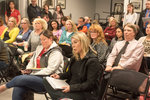

Despite pushback from the Centralia teacher’s union, the Centralia School Board adopted a new boundary map for the K-6 elementary school configuration the district plans to implement this fall.
During the Centralia School Board’s regular meeting on Wednesday evening, 11 people spoke during the public comment section. People spoke both for and against the boundary changes, and the comments were split almost evenly between support for the Centralia School Board and requests to postpone the transition.
The Centralia teachers’ union, Centralia Education Association, voted “no confidence” in Centralia School District Superintendent Mark Davalos last week, stating that it opposes the new K-6 configuration. Centralia School Board member Amy Buzzard, who was board president at the time, sent a press release to The Chronicle that said the CEA unfairly placed “the weight of the decision’s consequences on Mr. Davalos.”
The Centralia School Board voted to adopt “Map B” for the new configuration. The most significant difference between the boundary maps was the Edison Elementary School boundary.
“I think if you go back and forth between the maps, you will see the small changes that this makes,” said Davalos of Map B at a Centralia School Board study session on Jan. 9. “The results of Map B, Edison is a little larger, as you will see later in that calculation, but they (students) will fit.”
Davalos said that people in the Centralia School District will be able to search which boundary they fall in in about a month.
“As soon as we work on the refinements of the design with our software company, we will be able to create an opportunity for families to go (online) and type in addresses,” Davalos said.
These boundary lines will shift as the result of a $74 million bond voters approved in February 2017 for capital improvements.
The bond was to “Undertake renovation and modernization of Centralia High School” and “Make needed expansions, safety and security improvements, modernizations, and/or replacements” to Jefferson Lincoln and Fords Prairie Elementary Schools, according to the bond resolution.
The bond resolution, however, does not mention all elementary schools in the district transitioning to the K-6 model. The Chronicle submitted a public records request to the district for “Minutes from the public hearing the Centralia School Board held to change all elementary schools in the Centralia School District to the K-6 configuration” and “The resolution the Centralia School Board adopted to change all elementary schools in the Centralia School District to the K-6 configuration” on Tuesday. The district has five days to respond to the records request.
When asked Wednesday if the Centralia School Board passed a resolution to change all five elementary schools to the K-6 configuration, Davalos said he was not sure.
“I know that we, in talking about the new schools, we said K-6,” Davalos said. “That resolution was inclusive of all five. There is language somewhere we are doing all five. … The bond is specific to what you are going to build.”
Board member Bob Fuller became the Centralia School Board president Wednesday, after the school board reorganized. He did not respond to the same question via text message Wednesday evening.
The bond resolution also explicitly states the improvements for the elementary schools are meant to remove portable classrooms, create two new K-6 elementary schools — each with a gym and separate cafeteria/multipurpose rooms — and that the schools will house approximately 525 students.
According to the bond language, “If the Board shall determine that it has become impractical to accomplish any of such Improvements or portions thereof by reason of state or local circumstances, including changed conditions, incompatible development or costs substantially in excess of those estimated, the District shall not be required to accomplish such Improvements and may apply the Bond proceeds or any portion thereof to other portions of the Improvements, to other capital improvements, or to payment of principal of or interest on the Bonds, as the Board may determine after holding a public hearing theron pursuant to RCW 28A.530.020.”
That statute states the school board must first hear public testimony before adopting a new resolution to amend the original resolution that voters approved.
According to RCW 28A.530.020, “If the school board subsequently determines that state or local circumstances should cause any alteration to the specific expenditures from the debt financing or of the state assistance, the board shall first conduct a public hearing to consider those circumstances and to receive public testimony. If the board then determines that any such alterations are in the best interests of the district, it may adopt a new resolution or amend the original resolution at a public meeting held subsequent to the meeting at which public testimony was received.”
Davalos estimated Wednesday that each new school will house approximately 450 students.
“We could fill all classrooms and get closer to 500 or over, but we keep smaller class sizes and, because of that, the numbers will be smaller any time you do that,” Davalos said. “We could be flexible. A school could hold 550, but we don’t try to have class sizes that big, so they’ll be less.”
Fuller said Wednesday the Centralia School Board did not hold a public hearing or adopt a resolution for Jefferson Lincoln and Fords Prairie Elementary Schools to house fewer than 525 students. When asked if he considered a school that would house 450 students approximately the size of one that would house 525 students, he said, “I guess I would.”